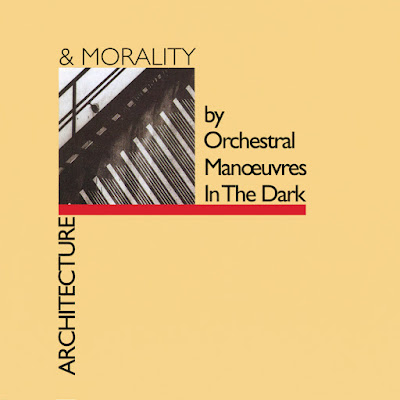November
5th marks the 40th anniversary of the release of the third album by OMD
(Orchestral Maneuvers in the Dark), Architecture & Morality, which
was issued on this day in 1981. It’s an album that redefined electronic
music’s potential, though it was clearly a shot over the heads of some
critics of the day.
At the time work began on the A&M album,
OMD were looking to infuse a fresh sense of warmth and humanity into the
often cold, mechanical landscape of the growing electronic music scene.
This was a trend that was working its way through the ranks of other
synth driven artists like John Foxx, who’d done an about-face from his
debut solo album, with all it’s grey metallic machinations, to the green
of forgotten gardens with his follow-up. For OMD, their inspiration
for where to find warmth and humanity in their music came from religious
choral music, thanks to some experiments from former OMD member, David
Hughes, who was using the group’s studio to tinker with some processed
choral recordings he’d made. Though the group were themselves not
religiously inclined, they appreciated the power and emotive capacity of
the music. With this in hand, they focused on historical themes and
characters to provide a conceptual framework for the album.
The
title was suggested by Martha Ladly (Martha & the Muffins) after the
1977 book Morality and Architecture by David Watkin. The group felt
that the duality suggested by the words perfectly meshed with their
desire to take the rigid “architecture” presented by electronic
instruments like drum machines, sequencers and synthesizers, and balance
them with the “morality” of the human experience. The cover by
acclaimed designer Peter Saville, known for his work with Factory
Records and Joy Division, austerely reflected this concept and
reinforced the thematic integrity of the entire project. Ladly &
Saville were, incidentally, romantically involved at the time the album
was produced.
Musically, the group went to great lengths to
expand their sonic palette beyond the usual synths and drum machines,
incorporating acoustic instruments, guitars and especially a vintage
Mellotron, a rather unwieldy keyboard contraption that predated digital
sampling by utilizing banks of audio tape loops of real instruments to
create its sounds. Its presence often lends a haunting sense of surreal
romanticism to the album’s aura. Structurally, the songs have a
stately, procession type of movement to them. There’s a sense of drama
and scale, though never bombastic or overblown. The results come across
as heartfelt and sincere as they delve into the history and impact of
their subjects.
The initial critical response to the album was
baffling and mixed, however. After putting so much into this project,
the group were taken aback by how harsh some critics were. Lynden
Barber of Melody Maker wrote, "I don't believe the Orchs even care about
this record... the style is the same, the content profoundly different,
the onslaught of emptiness, frivolity disguised by furrowed brows, a
new brand of meaninglessness." The response of the listening public,
however, was immediately enthusiastic and the album spawned no less than
three hit singles in the UK and European markets. The tide of
negativism from the critics soon shifted, however, as the fog began to
clear from their perception of the album and people began to comprehend
the scope of what the group had accomplished. The critical standing of
the record after 40 years on the shelves now puts it solidly in the
“classic masterpiece” category with it frequently topping “best of the
80s” lists.
For me, it was my gateway drug for OMD and still
sits as their high water mark as far as my personal estimation of their
career is concerned.
